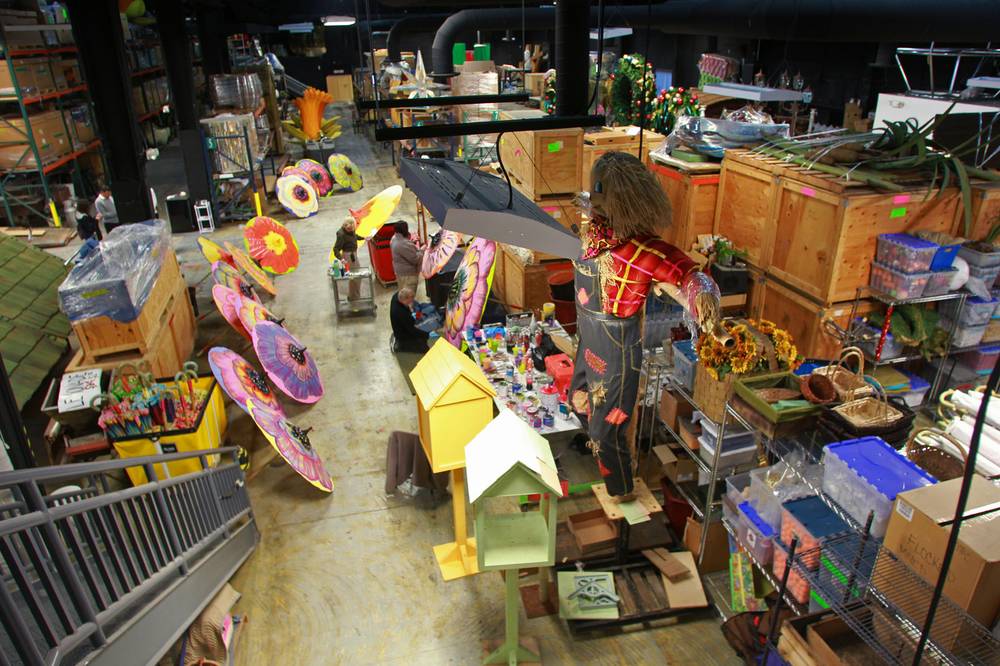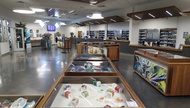Andres Garcia stands at the edge of the Bellagio Conservatory & Botanical Gardens, watching the crowd snap photos and coo over the Chinese New Year display. In a simple sweater over a white button-down shirt, the El Salvadoran immigrant looks like any other tourist admiring the view: the money tree bursting with 384 gold-leafed coins the size of Frisbees, the traditional pots burning incense, the clusters of red silk lanterns symbolizing happiness and prosperity. At the center of the exhibit, life-size galloping horses encircle a three-tiered mountain crowned with a 15-foot rearing golden stallion. 2014 is the Year of the Horse.
“It’s breaking my heart to see this one go,” says Garcia, Bellagio’s director of horticulture.
In a few days, he and a crew of about 100 will begin dismantling the exhibit, working in shifts around the clock for a week to take apart the custom tableau they spent more than six months planning. When their work is done, spring will have sprung inside the Bellagio—and nearly every trace of Chinese New Year will have vanished. But at the conservatory, there’s no such thing as permanent retirement.
“Oh good, you have my plants,” Garcia says to Conservatory Manager Patricia Streeter, as we duck behind a black curtain on the first floor of the Bellagio parking garage. Before us are rows of blossoms and bushes—bougainvillea, lilies, forest pansies—and Garcia greets them like nieces he hasn’t seen in years, bending over to examine petals and leaves, inhaling deeply here and there. Even inside this concrete box, the air smells like a field of flowers. It’s mildly disconcerting—and totally intoxicating.
The rest of the conservatory’s plants are a few miles away in a warehouse off Oquendo Road, where a team of 12 tends to the living part of the Bellagio’s rotating exhibits. Tulips are ordered a year ahead of time from California and Utah. “The growers have to grow for our specifications,” Streeter says. Peonies, she adds, just don’t work.
Managing the flowers is a tricky timing dance. To ensure everything hits the conservatory floor in full bloom, the warehouse staff must play Mother Nature, setting some plants under grow lights and putting others into hibernation.
“We mess with them,” Garcia says, hoisting the back gate on a refrigerated truck where thousands of closed tulips are sitting in the dark at 45 degrees. “We keep them asleep.”
When a plant is done flowering it’s pulled from the display and replaced. Those in good condition are sold to employees with proceeds going to charity; those that are not are sent to “tulip heaven,” aka A1 Organics, where they will be made into mulch and eventually sold to growers. It’s a colorful reincarnation, something of a specialty for the Bellagio Conservatory.
The empty trunk of Bellagio’s talking tree looks out onto a bright orange daffodil as tall as a toddler in front of a huge bald eagle, wings stretched in a permanent salute. A few steps away, bulldog-sized honeybees hang in careful rigging next to a massive model of the Liberty Bell. Garcia sits down next to the crack and strikes a casual pose. “Next time you’re missing Philadelphia, you just call me.”
We’ve just walked inside a nondescript building on Industrial Road that Garcia alternately calls his “toy shop,” “museum” and “warehouse heaven.” Officially, the sprawling spread is the storage facility and workshop for the conservatory’s non-living décor, but it feels like wandering through some employee-only door at Disneyland into the guts of the wonder machine.
Everywhere you look there are remnants of past exhibits and hints of future ones: Winter’s polar bears, a Chinese New Year junk boat, people painting vibrant flowers onto paper parasols for the upcoming spring show. Small items are packed into crates and cardboard boxes, stacked on rows of metal shelves. Larger props cluster around the edges—a giant tiger, a two-story scarecrow, a topless rocking horse that’s lost most of its torso somewhere. Forty-four trailers hold the rest of Garcia’s vast prop empire. Soon, the money tree and the Chinese lanterns will find a home here, too.
But they won’t just sit around and collect dust. Not necessarily. Garcia says most items eventually find a second life—some reused every year, some resting for years at a time. Only rarely does a prop feel so specific to a single display that the conservatory staff lets it go, like Bella the Chinese New Year pig, which was donated to Opportunity Village.
I imagine the conservatory’s herd of noble horses taking over a corner of the warehouse, huddling next to Christmas ornaments and icebergs, manes still blowing in the non-existent wind. Their exile feels a little sad—one day the stars of a gorgeous, epic show, the next relinquished to a quiet spot among the cast-offs, far from the tourists and constant camera flashes.
But Garcia just smiles. As soon as spring’s hand-painted parasols and butterfly habitat are packed away, he says, the horses will return. They’re starring in the summer display this May.





